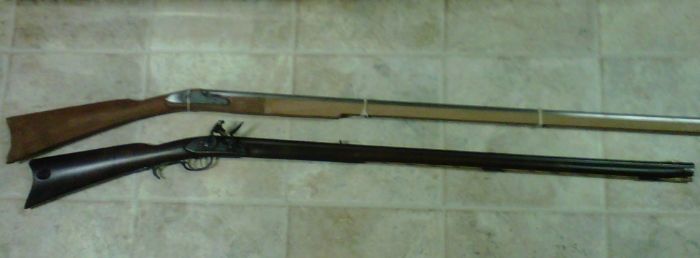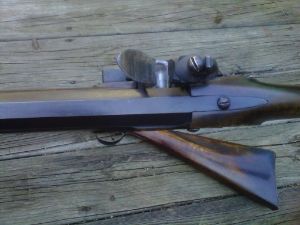It's my opinion that rifles made from 1800 to about 1820 are the pinnacle of the American longrifle. In a sense, rifles from that era are hard to describe in words. If you do some real research on these rifles and their architecture, you can easily spot them. It's one of those things, with some education you'll know it when you see it.
I'll try to give a brief description of a rifle made during that era, 1800s-1810s.
Long, Slender and Refined.
Barrel: 42 to 50+ inches in length with 42 to 46 inches being quite common. Hand forged barrels will be swamped or tapered. The swamp will not be as profound as on a 18th Century rifle. In this era you start to see early factory straight barrels. Keep in mind that even some hand forged "swamped" barrels from this era, have such a slight swamp that it is not detectible by the naked eye. Caliber .30s to mid .50s with mid to upper .40s being the most common.
Barrels can be Cold rust blued, charcoal blued, in the white or browned.
Wood: Maple, Walnut, Cherry, Ash and other oddball woods in that order. I would say mid-grade maple by far the most common.
Stock: Here is where IMHO, it's difficult to put into words. Firstly is a certain grace, They do not call it the "Golden Age" for nothing. One feature that I see that is quite common in this era and seems to be found in many regions is a Oh So slight Roman nose in the comb and a Oh So slight gentle curve on the bottom of the stock from the triggerguard to the toe.
As time progresses inlays tend to replace carving as decoration. In this era you see many rifles with a pleasant balance of carving and inlays.
A good majority of these rifles will be trimmed in brass. In the South you really start to the early iron trimmed mountain rifles, sometimes with a mixture of iron and brass. Some high end rifles will be trimmed in silver or have a mixture of silver and brass.
Engraving like carving seems to be less and less as the years go by.
Butt plates will have a gentle curve, not as flat as Rev War or early Golden Age but not as severe a curve as the later crescent butts.
Barrels can be pinned or keyed.
Full metal "Brass" patch boxes most are engraved some not. Wood boxes can still be found especially on rifles by older makers like Beck but they tend to be an exception for the era. A wood box rifle tends to be less decorated than a Metal box rifle.
Lock: English export locks like the Ketland Design and American hardware variety locks are quite common even on some Penn made rifles. Early in the era the locks will have a pointed "teet" at the rear of the plate. As the era progresses, circa 1810, locks with rounded off tails come into to style. Some makers still continue to make their own locks or use the Germanic style like Beck, Dickert and Armstrong.
Sights will be Lowww, especially the front sight and commonly with a silver blade. Some front sight blades are so low and long the are hard to see from the side.
Keep in mind these are my observations of a "common" circa 1810 rifle. They're are many different regions and schools of rifles from this period. Some Rifles like all things made by the hand of man from that era man may be different than described above. So it's up to you to study and confirm the style and region of rifle you want.







